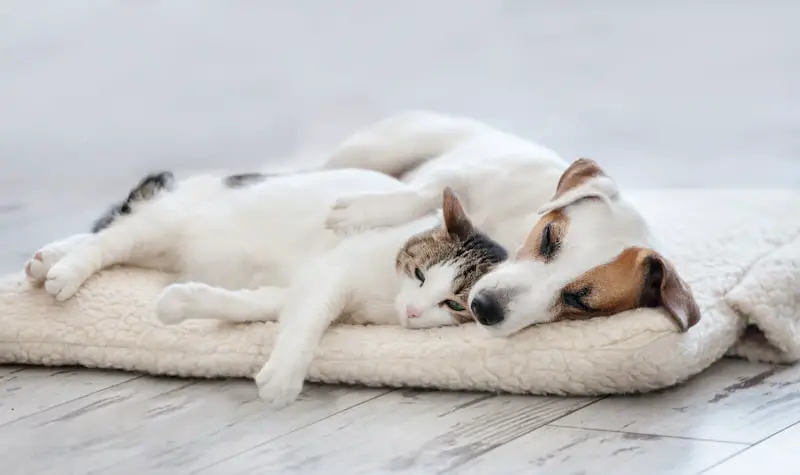Can cats and dogs get along? This is a question that has been asked by pet owners for years. It’s a common belief that cats and dogs are natural enemies and cannot coexist in the same household peacefully. However, the truth is that cats and dogs can get along if they are introduced properly and given time to adjust.
Personality of the Cat & Dog Matters
The first thing to consider is the personality of both the cat and dog. Some cats and dogs are naturally more social and friendly, while others may be more reserved or aggressive. It’s important to choose a cat and dog with compatible personalities. For example, a shy cat may not be able to handle a hyperactive dog, while an aggressive dog may be too intimidating for a timid cat.
In most cases, you’ll only be choosing one of the animals or neither. You probably already have a resident cat who thinks they’re king of their castle. Or maybe you recently had family move in and they brought along their dog.

Either way, many times you don’t get to choose the cat or dog based on their personality and whether they’ll get along well with other pets. If you do, great, but if not it’s not the end of the world.
Still consider the personalities of the pets. If you have a territorial cat, you may need to take longer in introducing them. Or it might be that your cat doesn’t do well with high energy dogs; in this case try introducing them after taking the dog for a long walk to tire them out.
Personality does matter, but it’s not the end all be all.
Introduce Slowly
The next step is to introduce them slowly and carefully. It’s best to keep the cat and dog separated for the first few days, allowing them to get used to each other’s scent. You can do this by swapping bedding or toys between the two animals. After a few days, you can introduce them in a controlled environment, such as a room with a baby gate.
During the initial introduction, it’s important to supervise the cat and dog closely. Keep the dog on a leash and let the cat explore at its own pace. Reward positive behavior with treats and praise. If the cat shows signs of aggression, such as hissing or swatting, remove it from the room and try again later.
Over time, the cat and dog will become more comfortable around each other. You can gradually increase their interactions by allowing them to spend more time together, always under close supervision. It’s important to give the cat a safe space to retreat to if it feels threatened, such as a high shelf or a separate room.
Peaceful Coexistance Might be All You Can Get
In some cases, cats and dogs may never become best friends, but they can still coexist peacefully. As long as they are given the space and time to adjust, they can learn to tolerate each other’s presence.
Make sure the dog and cat have their own respective places they can go to escape from one another. You may need to keep them physically separated for a long time before they can be in the same room together unattended.
Give your cat high places they can go to be away from the dog. Cat trees and high shelves are great places for a cat to escape to.
How Long Does it Take for Cats and Dogs to Get Along?

The real question everyone wants to know is how long it takes for cats and dogs to get along. And the disappointing answer is, it varies. There’s really no surefire way to tell exactly how long it’ll take for a cat and dog to get along. In some cases, it can take days. In other cases, it might take up to a year. Some dogs and cats will just never get along.
The key here is to have patience and never rush their interactions. Trying to integrate pets too quickly can cause tensions to rise and trust to be broken. One swipe of a paw or an aggressive chomp can leave scars that leave them unable to form bonds in the future.
FAQs: Can Cats and Dogs get Along?
The time it takes for a cat to get used to a dog can vary greatly depending on the individual animals involved, their previous experiences with each other or other animals, and the way they are introduced to each other. Some cats may adjust quickly to a new dog, while others may take weeks or even months to become comfortable around them.
Studies have shown that cats are more apprehensive around dogs than the other way around. They view dogs as being more threatening than dogs view cats as threatening.
Cats are also more fiercely territorial than dogs and more unwilling to relinquish their territory.
So the key is if you can 1) get a cat to feel safe around the dog and 2) get used to the dog being in their territory, then you’ll be successful.
Whether or not your dog will accept a cat largely depends on their individual personality and temperament, as well as their previous experiences with cats or other animals. Some dogs may be more accepting of cats, while others may have a strong prey drive and see cats as potential prey.
There are a few ways to tell if a dog has a prey drive and sees cats as prey. One of the ways is if they become fixated on the cat. This means they’re intently focused on the cat, staring at them and unable to break their gaze. Excitability and whining toward the cat are also signs. If the dog is trying to pull towards the cat or frantically lunge at them, it might also mean they have a prey drive.
Dogs don’t necessarily always see cats as prey even if they do have a prey drive. With careful patience, you can train a dog to see cats as being part of the pack and not prey.
It’s also worth noting that the way you introduce them is crucial to how your dogs will see the cat. Also, if the cat sprints away, this might trigger the dogs’ prey drive.
Slow and steady wins the race, and that applies here as well.
Deciding whether to get a dog or a cat first largely depends on your lifestyle and personal preferences. Both dogs and cats make great pets, and each has its own unique qualities.
If you are someone who enjoys an active lifestyle and has plenty of time to devote to a pet, a dog may be the better choice for you. Dogs require daily exercise and regular training, which can provide a great opportunity for you to get outside and stay active.
On the other hand, if you prefer a more low-key lifestyle and don’t have as much time to devote to a pet, a cat may be a better option. Cats are generally lower maintenance than dogs, and they can be more independent.
If you know you’ll eventually get both, and are wondering which way will be easier to introduce them, then get a dog first.
The reason is because cats are fiercely territorial. Cats have been known to grow accustomed to their only-pet status, and be very disgruntled at new pets.
It’s generally ok for dogs and cats to live together, with some exceptions. It’s never ok to leave dogs and cats together unattended if one or more of the dogs has a strong prey drive. Even if they seem ok for the most part, some dogs are triggered by certain behaviors, like if your cat sprints away.
Therefore, it really depends on the pets themselves whether they can live together.
Always introduce slowly and observe their behaviors closely. The best case scenario is if the dogs and cats are just ignoring each other or disinterested in each other. Signs of relaxation like turning their backs to each other or sleeping around each other are good signs.
While any breed of dog can potentially get along with cats, there are some breeds that are known to be more cat-friendly than others. Here are a few breeds that are often reported to have a good temperament with cats:
– Golden Retriever – This breed is known for its gentle nature and patience, making them a great choice for families with cats.
– Cavalier King Charles Spaniel – These dogs are typically friendly and affectionate towards other animals, including cats.
– Beagle – Beagles are often easy-going and social, which can make them a good match for cats.
– Bichon Frise – These dogs are generally friendly and non-aggressive, which can make them a good choice for families with cats.
– Labrador Retriever – Another popular breed that is known for its gentle nature, Labs often do well with cats.














